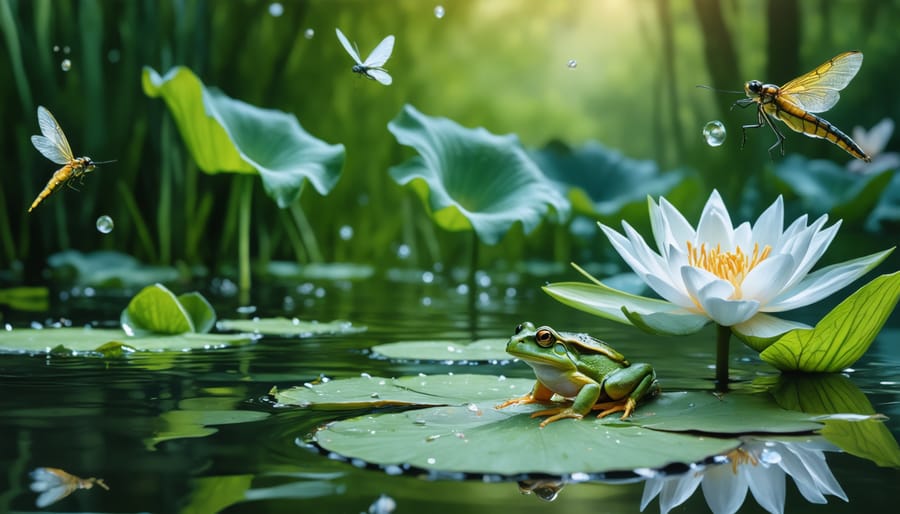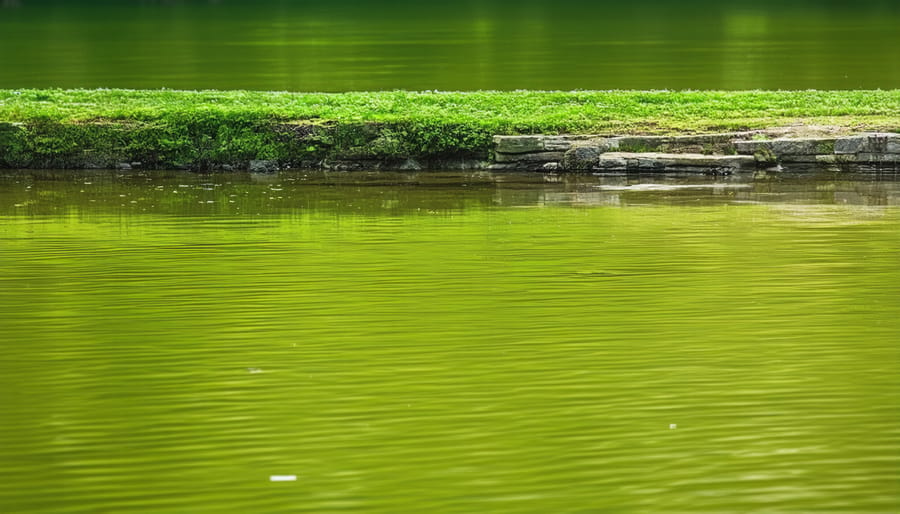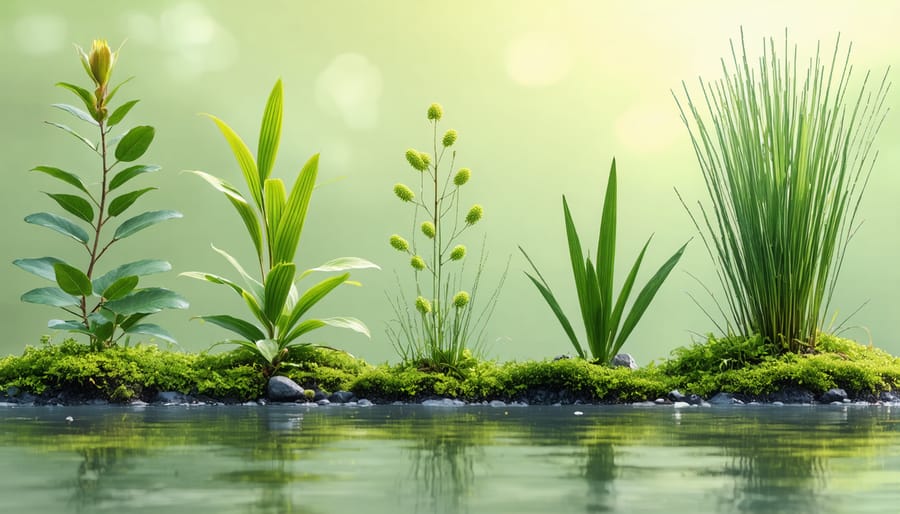
How Your Backyard Pond Helps Save Local Wildlife (And Makes a Difference)
Transform your backyard pond into a thriving ecosystem that protects local wildlife and conserves precious water resources. Creating a natural habitat through thoughtful pond design delivers far more than just aesthetic beauty – it actively supports environmental preservation and enhances biodiversity right in your own garden. From providing essential breeding grounds for beneficial insects and amphibians to naturally filtering rainwater and reducing urban runoff, conservation-focused ponds play a vital role in supporting local ecosystems. Whether you’re planning your first water feature or looking to enhance an existing pond, understanding these conservation benefits helps you make design choices that maximize environmental impact while creating a stunning outdoor sanctuary. By incorporating native plants, maintaining healthy water quality, and following sustainable maintenance practices, your pond can become a powerful force for local conservation efforts while bringing the peaceful sound of flowing water and fascinating wildlife to your daily life.
Creating Safe Haven for Native Wildlife

Supporting Local Amphibians
Creating a backyard pond does more than just enhance your garden’s beauty – it provides crucial habitat for local amphibians. Frogs and salamanders are experiencing declining populations worldwide, but your pond can become a thriving ecosystem that helps protect these fascinating creatures.
These sensitive animals need clean water for breeding and development of their young. By maintaining a chemical-free pond with plenty of native plants, you’re creating a safe haven where frogs can lay their eggs and tadpoles can develop. Salamanders benefit from moist areas around the pond’s edge and appreciate features like partially submerged logs and stone piles.
To make your pond more amphibian-friendly, include gently sloping sides for easy access and exit, provide various water depths, and incorporate plenty of natural cover like aquatic plants and rocks. The sound of croaking frogs at night isn’t just pleasant ambiance – it’s a sign that you’re making a real difference in local conservation efforts. Remember, even a small pond can become an important stepping stone between natural habitats, helping these creatures maintain healthy populations in urban and suburban areas.
Bird and Insect Benefits
Ponds are natural magnets for beneficial wildlife, creating a vibrant ecosystem right in your backyard. Birds flock to these water features for drinking, bathing, and cooling off, while also helping control garden pests. Species like swallows and chickadees catch mosquitoes and other insects on the wing, providing natural pest management around your pond.
Dragonflies and damselflies are particularly drawn to pond environments, where they lay their eggs and help control mosquito populations. These beautiful insects can consume hundreds of mosquito larvae daily, making your outdoor space more enjoyable. Beneficial pollinators like bees and butterflies also visit ponds regularly, using them as water sources while pollinating nearby plants.
Your pond can become a crucial pit stop for migrating birds, especially in urban areas where natural water sources are scarce. By providing clean, fresh water, you’re creating an essential wildlife corridor that helps sustain local and migrating species. Even small ponds make a significant difference, offering drinking water during dry spells and supporting insects that form the base of the local food chain.
Water Conservation Heroes
Natural Water Filtration
A natural pond ecosystem acts as a remarkable water filtration system, working tirelessly to maintain clean, healthy water. Plants, beneficial bacteria, and various microorganisms work together in perfect harmony to break down organic matter and filter out impurities. Aquatic plants, especially submerged varieties, absorb excess nutrients and help prevent algae growth while producing oxygen that keeps the water fresh.
The bottom substrate of your pond plays a crucial role too. Layers of gravel and sand create surfaces where beneficial bacteria can thrive, forming a biological filter that processes waste materials. These bacteria convert harmful ammonia from fish waste into less harmful compounds, maintaining water quality naturally.
Water movement through plant roots and substrate creates a natural purification process similar to how wetlands clean water in nature. This filtration system helps reduce the need for chemical treatments and mechanical filters, making your pond more sustainable and environmentally friendly. The cleaner water also supports a healthier ecosystem, encouraging more wildlife to visit and making maintenance easier for you as a pond owner.

Rainwater Collection Benefits
Installing a rainwater collection system for your pond offers tremendous environmental and practical benefits. By capturing and storing rainwater, you can significantly reduce your reliance on treated municipal water while maintaining optimal pond levels. This sustainable approach not only saves money on your water bill but also helps preserve our precious water resources.
During heavy rainfall, your pond can act as a natural buffer, preventing excess water from overwhelming local drainage systems and reducing the risk of flooding in your yard. The collected rainwater is naturally soft and free from chemicals, making it ideal for both your pond inhabitants and surrounding plants.
You can enhance your collection system by incorporating features like rain gardens or bioswales around your pond. These natural filtration zones help clean the water before it enters your pond while creating additional wildlife habitats. Plus, stored rainwater serves as an excellent backup during dry spells, ensuring your pond ecosystem stays healthy year-round.
For maximum efficiency, consider adding overflow areas that direct excess water to your garden beds, creating a complete water-smart landscape that benefits your entire outdoor space.
Plant Preservation and Biodiversity
Native Aquatic Plant Protection
Native aquatic plants are the unsung heroes of pond ecosystems, playing a vital role in maintaining water quality and supporting local wildlife. These indigenous plants have evolved alongside local species, creating perfect natural habitats for native fish, amphibians, and beneficial insects. By incorporating native water lilies, rushes, and other local aquatic plants into your pond, you’re helping preserve these important species and their genetic diversity.
When selecting plants for your pond, look for varieties that naturally occur in your region. These plants are already adapted to your local climate and seasonal changes, making them easier to maintain and more likely to thrive. They also provide natural filtration, helping to keep your pond water clear while reducing the need for artificial treatments.
To protect native species, avoid introducing invasive plants that can outcompete local varieties. Many popular ornamental pond plants can become aggressive spreaders if not carefully managed. Instead, contact local nurseries or aquatic gardening specialists who can recommend native alternatives that offer similar aesthetic appeal while supporting your local ecosystem.
Remember to research proper planting depths and spacing requirements for each species to ensure they establish successfully in your pond.
Creating Microhabitat Connections
A well-designed pond creates vital connections between different parts of your garden ecosystem, acting like nature’s highway system. When you install a pond, you’re actually building bridges between various microhabitats that support different forms of life. The shallow edges provide drinking spots for birds and small mammals, while deeper zones offer safe havens for fish and aquatic insects.
The pond’s surroundings are just as important as the water itself. Adding rocks and logs around the edges creates shelter for beneficial insects and amphibians, who can move safely between land and water. Native plants near the pond’s edge help filter runoff water and provide natural corridors for wildlife movement.
These habitat connections work in layers – from the pond bottom where beneficial bacteria thrive, through the water column where fish swim, to the surface where insects skate, and up to the air where dragonflies patrol. Each layer supports the others, creating a complete ecosystem that enhances your entire garden’s biodiversity.
By maintaining these connections, your pond becomes a crucial linking point in the local environmental network, supporting wildlife movement and creating a more resilient garden ecosystem.
Making Your Pond a Conservation Champion
Best Plants for Wildlife
Creating a wildlife-friendly pond starts with choosing the right plants for each of your pond zones. Native aquatic plants like water lilies and rushes provide essential shelter for fish and amphibians, while also helping maintain water quality. Along the margins, plants such as iris and sedges create perfect hiding spots for frogs and newts.
Consider including flowering plants like purple loosestrife and marsh marigold, which attract pollinators like bees and butterflies. These not only add beautiful splashes of color but also support local insect populations. Submerged oxygenating plants, including hornwort and water milfoil, are fantastic for maintaining water clarity and providing spawning areas for fish.
For maximum wildlife impact, aim for a mix of different plant heights and types. Tall marginals like cattails offer nesting sites for birds, while floating plants provide shade and protection for pond life below. Remember to include some shallow areas with moisture-loving plants that will attract beneficial insects and create natural stepping stones for wildlife visiting your pond.

Maintenance for Conservation
Regular maintenance is key to keeping your pond a thriving haven for wildlife. Start by monitoring water quality monthly, checking pH levels and ensuring proper oxygen circulation. Remove fallen leaves and debris regularly to prevent excess nutrient buildup, which can lead to algae problems and affect water quality for pond inhabitants.
Trim aquatic plants as needed, but avoid over-pruning as these provide essential shelter for wildlife. Leave about one-third of vegetation during fall cleanup to provide winter habitat for beneficial insects and amphibians. If you have a pump or filter system, clean it seasonally to maintain optimal water flow while being careful not to disturb any resident creatures.
Create gentle slopes around the pond edges to help animals easily access the water. Maintain shallow areas where birds can safely drink and bathe. Consider adding partially submerged logs or rocks that serve as basking spots for turtles and landing pads for dragonflies.
During drought periods, keep water levels consistent by topping up with collected rainwater rather than treated tap water. This helps maintain a stable environment for your pond’s ecosystem while supporting local wildlife conservation efforts.
Creating a backyard pond is more than just adding a beautiful water feature to your landscape – it’s taking an active role in environmental conservation. By maintaining a healthy pond ecosystem, you’re providing a vital sanctuary for local wildlife, supporting endangered amphibian populations, and contributing to biodiversity right in your own backyard.
Your pond can serve as a stepping stone habitat, connecting fragmented wildlife corridors and offering safe havens for migrating species. Every new pond adds to a growing network of water sources that help wildlife thrive in urban and suburban environments.
The impact of your backyard pond extends beyond its borders. By implementing eco-friendly maintenance practices, harvesting rainwater, and choosing native plants, you’re helping conserve water resources and maintain ecological balance in your local area.
Take the first step today by planning or enhancing your pond with conservation in mind. Whether you’re adding native aquatic plants, creating shallow areas for amphibians, or installing a wildlife-friendly filtration system, every action counts. Together, we can create a network of healthy backyard ponds that make a real difference in protecting our natural environment for future generations.
